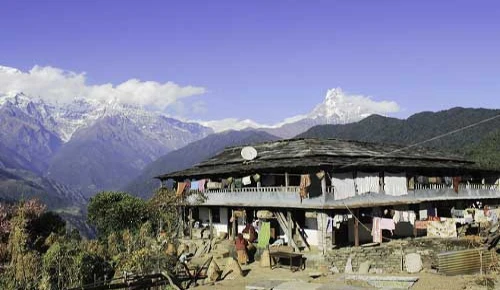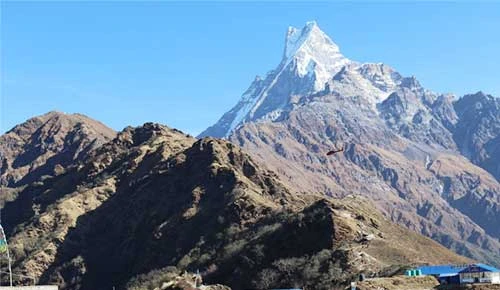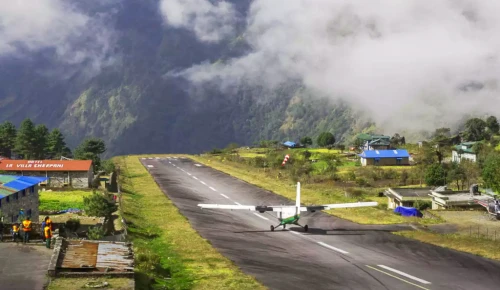Annapurna Conservation Area, Nepal
Annapurna Conservation Area is Nepal's largest protected area, spanning 7629 square kilometers in the Annapurna mountains of the Himalayas. This area is home to some of the world's highest peaks, including the famed Annaurna I, which stands at over 8091 meters tall.
The Annapurna Conservation Area (ACA) is a top destination for hikers and environment lovers, recognized for its beautiful scenery and various ecosystems. This protected area was established in 1986 and ranges in elevation from 760 to 8091 meters.

The Annapurna Conservation Area Project (ACAP) was created to meet the needs of long-term conservation and tourists in this environmentally sensitive area. The National Trust for Nature Conservation (NTNC), which is in charge of running ACAP, made an effort to strike a balance between preserving the environment and boosting the economy.
It was Nepal's first and largest conservation area, and it is well-known for its combined approach to natural resource protection and the promotion of sustainable livelihoods for local residents.
Table of Contents
Annapurna Conservation Area
Location and Size
The Annapurna Conservation Area (ACA) is situated in the Himalayas of north-central Nepal. It covers approximately 7,629 square kilometers (2,946 square miles) and is one of Nepal's largest protected areas. The region includes sections of the Manang, Mustang, Kaski, Myagdi, and Lamjung districts, with different landscapes ranging from subtropical forests to alpine meadows and bleak high-altitude terrain.

History and Establishment
The Annapurna Conservation Area, established in 1986, was Nepal's first and largest conservation area. It was founded in response to the need to protect the region's rich biodiversity and fragile ecosystems, which were in danger from unsustainable development and increased tourism. The Nepalese government initiated the initiative, which involved local people, conservation organizations, and foreign partners.
Ojectives
- Conservation of natural resources in the Annapurna region.
- Protecting and preserving wildlife habitats and biodiversity.
- Sustainable management of tourism operations to have the least amount of damage on the environment.
- The socioeconomic advancement of local communities through conservation-based initiatives.
- Encouragement of community engagement in conservation efforts.
- Preserving the region's cultural history and customary traditions.
- Supporting conservation and sustainable development research and education activities.
- Collaboration with government agencies, non-governmental organizations (NGOs), and local stakeholders to achieve conservation objectives.
- Establishment of appropriate monitoring and enforcement measures to ensure compliance with conservation regulations.
- Using both old and new methods together in protection and resource management.
Role of Annapurna Conservation Area Project
The Annapurna Conservation Area Project (ACAP), established in 1986, shows Nepal's dedication to sustainable development and environmental protection in the Annapurna Region. The National Trust for Nature Conservation (NTNC), which runs ACAP and receives funding from the government of Nepal and international partners, seeks to protect the region's diverse natural and cultural assets while also enhancing the socioeconomic circumstances of the local population.

Conservational Efforts
ACAP has played a key role in adopting a wide range of conservation efforts aimed at safeguarding the region's natural resources. These efforts include the following:
- ACAP implements measures to protect wildlife, like snow leopards and red pandas, from poaching and illegal trade.
- It leads afforestation projects and promotes sustainable forest management to maintain ecological balance.
- ACAP works with law enforcement to increase anti-poaching efforts, helping conserve wildlife in the region.
Community Development
ACAP promotes community-based conservation, acknowledging local communities' vital role in the sustainable management of natural resources. ACAP wants to improve the social and economic well-being of local people and teach them to care for the environment through a variety of community development programs. Major initiatives include:
- It helps locals by offering training in eco-tourism, hospitality, and farming techniques.
- ACAP encourages eco-friendly farming methods, like terrace farming.
- It works to improve education and healthcare in remote mountain communities.
- ACAP builds schools, health posts, and offers scholarships to needy children.

Tourism Management
ACAP strives to achieve a careful balance between developing tourism and reducing its negative environmental effects . ACAP's goal is to maintain the long-term viability of tourism activities while preserving the Annapurna region's ecological integrity. Major initiatives include:
- It issues permits and enforces regulations to minimize environmental harm from trekking and mountaineering.
- ACAP builds eco-friendly trekking infrastructure like trails and lodges to enhance the trekking experience and create jobs for locals.
- The project conducts environmental education programs for tourists, guides, and communities to promote responsible tourism and reduce negative impacts on the environment.
Flora and Fauna of the Annapurna Conservation Area
Biodiversity and Wildlife
The Annapurna Conservation Area (ACA) boasts a rich biodiversity that encompasses a variety of ecosystems, ranging from subtropical forests to alpine meadows. Within its boundaries, there are over 1,200 species of flowering plants, including several endemic and rare species that thrive in the diverse climatic conditions.

Flora Highlights:
- Rhododendrons: The ACA is famous for its vibrant rhododendron forests, which bloom in a riot of colors during the spring season, painting the landscape with shades of red, pink, and white.
- Junipers and Oaks: As the altitude increases, the forests transition into mixed stands of juniper, oak, and pine trees, creating a picturesque backdrop for trekkers.
- Medicinal Plants: The region is also home to numerous medicinal plants that have been used for centuries in traditional Nepali medicine, contributing to the cultural and ecological significance of the area.
Fauna Highlights:
- Snow Leopards: One of the most elusive and iconic inhabitants of the ACA, the snow leopard roams the high-altitude regions, preying on Himalayan blue sheep and other mountain ungulates.
- Red Pandas: Another charismatic species found in the dense forests of the ACA is the red panda, known for its distinctive red fur and arboreal lifestyle.
- Himalayan Thar: These sturdy mountain goats are well-adapted to the rugged terrain of the Annapurna region, often spotted scaling steep cliffs and rocky slopes.
- Birdlife: The ACA is a paradise for birdwatchers, with over 450 species of birds recorded in the area, including the colorful Himalayan monal, lammergeier, and various species of pheasants.

Habitats
The Annapurna Conservation Area encompasses a wide range of habitats, each supporting unique flora and fauna adapted to its specific ecological conditions.
Subtropical Forests:
- Location: Found at lower elevations (below 1,000 meters), primarily on the southern slopes of the Annapurna massif.
- Flora: characterized by lush vegetation, including tropical hardwoods such as sal, chir pine, and rhododendron.
- Fauna: home to diverse wildlife, including langur monkeys, barking deer, and a variety of bird species.

Temperate Forests:
- Location: Occur at mid-elevations (1,000 to 2,500 meters), covering vast expanses of the ACA.
- Flora: Dominated by broad-leaved deciduous trees like oak, maple, and magnolia, interspersed with conifers such as fir and hemlock.
- Fauna: Provides habitat for mammals like the Himalayan black bear, Himalayan goral, and numerous bird species.
Alpine Meadows and Tundra:
- Location: Above 2,500 meters, extending up to the snow line and beyond.
- Flora: sparse vegetation consisting of hardy alpine plants, mosses, and lichens adapted to the harsh alpine environment.
- Fauna: supports specialized species such as the elusive snow leopard, Himalayan tahr, and Tibetan snowcock.
Trekking in the Annapurna Conservation Area
The Annapurna Conservation Area offers some of the most iconic trekking routes in the world, attracting adventurers and nature enthusiasts from across the globe. From the towering peaks of the Annapurna massif to the serene beauty of its valleys and forests, there's something for every type of trekker in this vast and diverse region.

Popular Treks
- Annapurna Circuit: The Annapurna Circuit, also known as the classic trek in Nepa, offers a complete trekking experience, circling the entire Annapurna massif. This trek takes you through a variety of landscapes, from lush green valleys to arid high-altitude deserts, and offers stunning views of peaks like Annapurna II, III, IV, and Gangapurna.
- Annapurna Base Camp Trek: For those seeking a closer encounter with the majestic peaks of the Annapurna range, the Annapurna Base Camp trek is the perfect choice.With imposing peaks on all sides, including the well-known Machapuchare (Fishtail), this trek takes you right into the heart of the Annapurna Sanctuary.
- Ghorepani Poon Hill Trek: Ideal for beginners or those short on time, the Ghorepani Poon Hill trek offers breathtaking panoramic views of the Annapurna and Dhaulagiri ranges. The highlight of this trek is the sunrise view from Poon Hill, where you can witness the entire Himalayan range bathed in golden light.
- Mardi Himal Trek: Mardi Himal trek is less crowded trekking route, offering stunning views of the Annapurna range, Machapuchare, and Mardi Himal.
- Jomsom Trek: Starting from Pokhara, this trek to Jomsom takes you through the Kali Gandaki Valley, known for its dramatic landscapes, ancient villages, and Tibetan-influenced culture.
- Upper Mustang Trek: A remote and culturally rich trekking route to Upper Mustang that takes you into the hidden kingdom of Mustang region, known for its ancient Buddhist monasteries, caves, and unique desert-like landscapes.
- Tilicho Lake Trek: This challenging Tilicho trek leads to the highest lake in the world, Tilicho Lake, located at an altitude of 4,919 meters. Trekkers can enjoy breathtaking views of the surrounding peaks and glaciers.
- Nar Phu Valley Trek: This Nar Phu valley trek is a less-traveled trekking route that explores the remote Nar and Phu valleys, offering a glimpse into traditional Tibetan culture, ancient monasteries, and stunning mountain scenery.
- Khopra Ridge Trek: A less crowded alternative to the Ghorepani Poon Hill trek, offering panoramic views of the Annapurna and Dhaulagiri ranges from the pristine Khopra Ridge.
Best Time to Visit
The best time to trek in the Annapurna region is during the spring (March to May) and autumn (September to November) seasons. During these months, the weather is generally stable, with clear skies and moderate temperatures, making for optimal trekking conditions. Spring brings blooming rhododendron forests, while autumn offers crisp, clear views of the snow-capped peaks.

However, it's essential to be prepared for changing weather conditions in the Annaourna region at any time of the year, especially at higher altitudes. Trekkers should be aware of the potential for altitude sickness and acclimatize properly by ascending gradually and staying hydrated.
Permits Required for Annapurna Conservation Area
Annapurna Conservation Area Permit (ACAP):
This ACAP permit is mandatory for all trekkers entering the Annapurna Conservation Area. It helps fund conservation projects and maintain the area's infrastructure.
Trekkers' Information Management System (TIMS) Card:
The TIMS card is required for safety and security purposes. It helps track trekkers in the region, ensuring their safety and aiding in search and rescue operations if needed.
Special or Restricted Area Permits:
This permit is required if you trek to a restricted area of Annapurna Region of Nepal, like Upper Mustang or Nar Phu Valley. These permits are more expensive and have specific requirements, including trekking with a registered guide.
Conclusion
To summarize, the Annapurna Conservation Area is more than just a destination for trekkers looking for stunning scenery and exhilarating adventures; it is a protection of natural beauty and cultural legacy that requires our attention and protection. Thanks to the tireless work of the Annapurna Conservation Area Project (ACAP), this extraordinary region continues to thrive as a haven for wildlife, local populations, and visitors. As we bid farewell to this trekker's paradise, let us take with us the lessons of sustainable and responsible tourism, ensuring that future generations can enjoy the Annapurna Conservation Area's wonders.








